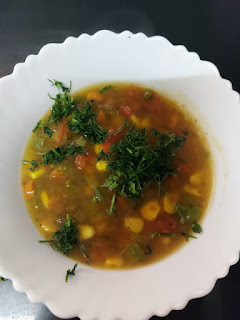Hearty and Nutritious Vegetable Soup Recipe
Warm Up Your Winter with This Delicious Vegetable Soup
Vegetable soup is a classic winter dish, perfect for warming you up on chilly days and providing a nutritious boost to your diet. Packed with seasonal vegetables and seasoned to perfection, this hearty vegetable soup is not only comforting but also incredibly healthy. Whether you're looking for a light meal to enjoy during lunch or a soothing evening dish, this vegetable soup recipe is a must-try!
Why Vegetable Soup Is Ideal for Winter
As the temperatures drop, our bodies crave warm, comforting meals that offer both flavor and nutrition. Vegetable soup is the perfect solution! This wholesome soup combines a variety of vegetables—carrots, potatoes, green beans, and peas—with herbs and spices to create a satisfying and flavorful dish. It's rich in vitamins, minerals, and antioxidants, making it a great option for boosting your immune system during the colder months.
Ingredients You'll Need
To make this delicious vegetable soup, you'll need a selection of fresh or frozen vegetables, some pantry staples, and a few seasonings. Here's what you will need:
- 1 tablespoon of olive oil (or your preferred cooking oil)
- 1 medium onion, finely chopped
- 2 garlic cloves, minced
- 2 large carrots, peeled and sliced
- 2 potatoes, peeled and diced
- 1 cup of green beans, chopped
- 1 cup of peas (fresh or frozen)
- 1 small tomato, finely chopped
- 4 cups of vegetable broth or water
- 1 teaspoon of dried oregano
- Salt and black pepper to taste
- Fresh parsley or coriander for garnish

Vegetable Soup Vegetable Soup
How to Prepare the Vegetable Soup
Sauté the Aromatics: Start by heating the oil in a large pot over medium heat. Add the chopped onions and minced garlic, and sauté them until they're soft and translucent. This will give your soup a wonderful base flavor.
Add the vegetables: Toss in the sliced carrots, diced potatoes, green beans, and peas. Sauté for a few minutes, stirring occasionally, to let the vegetables soak up the flavors from the onions and garlic.
Add the liquid: Pour in the vegetable broth or water. Bring everything to a boil, then reduce the heat and let it simmer. This will cook the vegetables until they become tender, releasing their flavors into the broth.
Season to Taste: Add oregano, salt, and black pepper to taste. Stir well to mix the seasonings throughout the soup. Adjust the seasoning as needed to enhance the flavor.
Simmer Until Ready: Allow the soup to simmer gently for about 20–25 minutes until the vegetables are tender. This long, slow cooking process helps to bring out the best flavor in the soup.
Blend or Leave Chunky: If you prefer a smoother soup, use an immersion blender to blend the mixture until creamy. If you enjoy a bit of texture, you can leave the soup chunky as is.
Nutritional Benefits of Vegetable Soup
Vegetable soup is a nutritional powerhouse, especially during the colder months. Packed with a variety of vegetables, vitamins, minerals, and antioxidants, it's a great way to give your immune system a boost while staying warm. This soup is also a fantastic source of dietary fiber, which supports healthy digestion. Plus, the added herbs and spices, like oregano and black pepper, provide anti-inflammatory properties to help keep you healthy during flu season.
Vegetable soup is also low in calories but high in nutrients, making it perfect for anyone looking to maintain a healthy diet without sacrificing flavor. It's a filling yet light option that offers plenty of vitamins and minerals without unnecessary fats or carbohydrates.
Vegetable soup is incredibly versatile, and you can easily customize it to suit your tastes and dietary preferences. For example:
- Add Protein: Toss in some cooked chicken, tofu, or chickpeas for extra protein.
- Include More Spices: Add spices like cumin, turmeric, or chili flakes for a spicier version.
- Use Different Vegetables: Feel free to swap out some of the basic ingredients for others you prefer—like zucchini, bell peppers, or sweet potatoes.
This soup is also a great meal prep option! You can make a big batch and store it in the fridge for several days or freeze it for a quick and nutritious meal whenever needed.
There's something special about a warm bowl of vegetable soup on a cold winter day. It's not just about warming up your body—it's about enjoying a delicious, healthy, and comforting meal. This vegetable soup recipe is easy to prepare, budget-friendly, and perfect for feeding the whole family. So why not try it today and bring a bit of warmth to your table?
This vegetable soup recipe is the perfect addition to your winter meal plans, providing a nutritious and comforting dish that's both satisfying and delicious. Give it a try and enjoy a cozy bowl of goodness to help keep you warm this winter!













